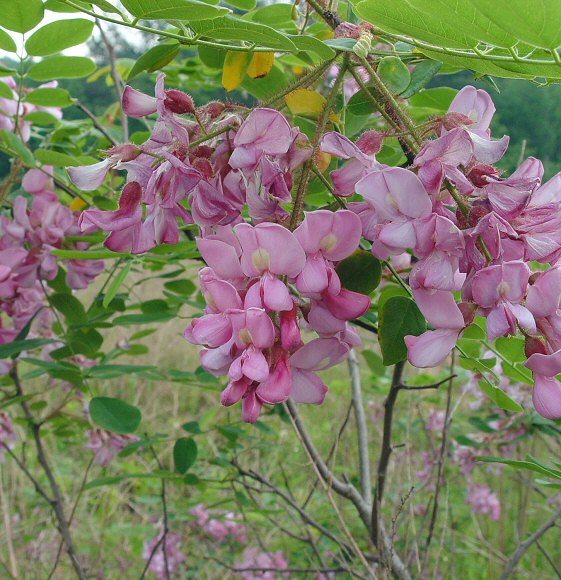Robinia hispida L.
Bristly Locust

Introduced
CC = *
CW = 5
MOC = 13
© DETenaglia
Robinia hispida L.Bristly Locust | |
 |
Introduced CC = * CW = 5 MOC = 13 |
© DETenaglia |
|
Family - Fabaceae/Faboideae Habit - Shrubs to 2.5 m tall, rhizomatous, root-suckering, and usually strongly colonial. Stems - Young stems conspicuously pubescent with stiff, spreading, purplish hairs 2-5 mm long, these gland-tipped when young, persistent for several seasons. Typically multiple but sometimes simple.
Leaves - Alternate, odd-pinnate, to 30 cm long, with 9-13 leaflets, the petiole 1.5-2.0 cm long, the rachis 9-16 cm long, densely bristly-hairy. Stipules 4-8 mm long, linear, soft or occasionally spinescent. Leaflets 3.0-5.5 cm long, 1.5-3.0 cm wide, broadly elliptic to ovate, the upper surface glabrous, the undersurface sparsely short-hairy, at least when young.
Inflorescence - Drooping axillary racemes of 4-11 flowers, to 10 cm long, the stalk and axis densely bristly-hairy and sometimes also short-hairy and/or glandular. Flowers with the stalk 5-8 mm long. Flowers - Calyces with the tube 4-6 mm long, densely hairy, the lobes 4-8 mm long, tapered to a sharply pointed tip. Corollas papilionaceous, pink or rosy purple, the banner 20-25 mm long, often with a lighter spot toward the base, the wings 16-22 mm long, 7-9 mm wide, the keel 16-20 mm long, 8-10 mm wide. Stamens diadelphous, tube to 1.4 cm long. Filaments 10-18 mm long. Anthers yellow-orange, 0.7 mm long. Ovary 8-10 mm long, tuberculate, the style upcurved, 10-12 mm long.
Fruit - Usually not produced. When present, 3-5 cm long, 3-5 mm wide, slightly flattened, densely pubescent with bristly purplish hairs 3-6 mm long. Seeds not produced in Missouri, the ovules aborting during seed development.
Flowering - May - June. Habitat - Cultivated and rarely escaped to open woods, slopes, and open thickets. Origin - Native to the southern U.S. Lookalikes - None. Other info. - This is a very striking plant not only for the flowers but also for the fruits and twigs. Although the plant is fairly common in cultivation, it rarely escapes and is relatively uncommon in Missouri. Thus far it has shown little propensity for invasion of intact natural communities. The plant can be identified by its large pinkish flowers, densely bristly twigs, and shrubby habit. Photographs taken near Birmingham, AL., 5-10-04 (DETenaglia); also along a highway median near Desloge, St. Francois County, MO, 5-21-2020, and near Hodenpyl Dam scenic turnout, Wexford County, MI, 7-06-2023 (SRTurner). |